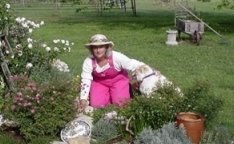|
|
 Lately,
I've read several "expert" articles about growing roses...whew, with all
the extensive soil preparation and additives, special feeding and spraying
schedule recommended in these articles, I felt as though working on a
Texas road crew in August would be more preferable to growing old roses...it
just doesn't have to be that intimidating, involved, time consuming, or
EXPENSIVE!!!
Lately,
I've read several "expert" articles about growing roses...whew, with all
the extensive soil preparation and additives, special feeding and spraying
schedule recommended in these articles, I felt as though working on a
Texas road crew in August would be more preferable to growing old roses...it
just doesn't have to be that intimidating, involved, time consuming, or
EXPENSIVE!!! Antique roses are very easy to grow; they are tough and can tolerate a wide range of growing conditions. They have survived for centuries, with and without care. So, with COMMON SENSE and no great addiction to rules in your pocket, allow me to guide you in growing beautiful, fragrant, old garden roses...in Texas!
 *
Select old roses that will tolerate our climate and soil, plant
only two gallon, own root roses. For suggestions, see my list in our book.
*
Select old roses that will tolerate our climate and soil, plant
only two gallon, own root roses. For suggestions, see my list in our book.
* Choose a sunny site with good air circulation...roses prefer 5-6 hours of sun a day and good air flow will help prevent powdery mildew.
* Preparing the soil... Start with good organic materials such as compost, shredded & decomposed leaves, finely shredded hardwood mulch, worm castings, composted manure, aged pecan shells, lava sand...add any or all of these and work in to existing clay or sandy soil…2/3 soil to 1/3 organic material…this good stuff will help loosen and enrich heavy clay soil, maintain nutrients in sandy soil and add microorganisms to any soil. Organic matter helps hold moisture and nutrients for plant growth, and provides food for earthworms and beneficial soil microorganisms.
* Plant your roses… creating a monoculture with roses will only invite problems, so plant a variety of herbs, perennials and flowering shrubs along with your old roses. Create a garden using the ancient principles of companion planting. for example… plant garlic and strong scented herbs around roses to deter aphids… but that's another story. Follow the guide to planting in our book, Ladies of the Garden. If you have established bed areas, it is simple to amend each hole as you plant a rose. I use worm castings and/or rabbit mature mixed 50/50 with soft rock phosphate. Sometimes I just use "Something Special" from Rabbit Hill Farm, as I always have that in the barn, mixed in to the existing soil.
 *
Watering and feeding… I don't heavily feed newly planted roses
in their first year. They need to have ample time for roots to establish
and produce strong new growth. Planting with and occasional root watering
with seaweed will stimulate good root growth. Thorough, deep watering
will help the roots settle in and go down deep in to the soil. Water at
least an inch a week in clay soil, more in sandy soil, just don't overwater.
In early spring, mid-summer and again in fall, I top dress with a cup
or two of "Something Special" by Rabbit Hill Farm. "Humalfa" in mid-summer
and fall is another good choice if you have it on hand. I foliar spray,
with Bioform and Agrispon, five or six times a season. Occasionally I
spray with Maxicrop seaweed to deter pests and strengthen foliage…I water
deeply, early in the morning, and always before foliar spraying or soil
feeding.
*
Watering and feeding… I don't heavily feed newly planted roses
in their first year. They need to have ample time for roots to establish
and produce strong new growth. Planting with and occasional root watering
with seaweed will stimulate good root growth. Thorough, deep watering
will help the roots settle in and go down deep in to the soil. Water at
least an inch a week in clay soil, more in sandy soil, just don't overwater.
In early spring, mid-summer and again in fall, I top dress with a cup
or two of "Something Special" by Rabbit Hill Farm. "Humalfa" in mid-summer
and fall is another good choice if you have it on hand. I foliar spray,
with Bioform and Agrispon, five or six times a season. Occasionally I
spray with Maxicrop seaweed to deter pests and strengthen foliage…I water
deeply, early in the morning, and always before foliar spraying or soil
feeding. * Mulch, mulch, and mulch… with at least three inches of finely shredded hardwood bark mulch and replenish each season as it breaks down. Mulch moderates soil temperature and helps to control weeds.
Well, there you have it and I still have time and energy left for all the other gardening things I like to do… smell the roses and lavender and thyme!
Pass it along!
Patricia Cowan is owner of Patricia's Homestead Gardening and co-author of the book "Ladies of the Garden."
